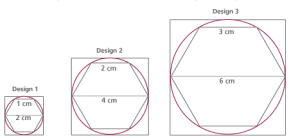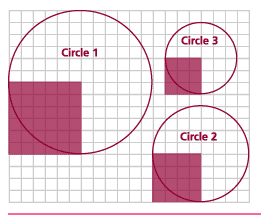Describe Ms. Scrivner’s techniques for letting students explore the relationship between circumference and diameter. What other techniques could you use?
I love the techniques Ms. Scrivner used in this lesson. First, she led a whole class discussion, giving the students the chance to recall what they already knew about the topic. She even referred to the mathematical vocabulary words written on the board and took the time to review them with the class. She had the students visualize what certain terms meant, as they used hand gestures to recall on previous lessons- such as giving a pumpkin a hug to remember what circumference means. She used certain tricks to have students remember the vocabulary as well. For example, there are two i’s in radii, so it must mean two or more “radius”. Once the students reviewed properly what they already knew, she led the class in a new lesson to discover the relationship circles have between their diameter and circumference. The students used centimeter tapes to find circles around the classroom that they could measure individually, and then met back with their group members to discuss their data. Then each group shared one circle and its measurements with the rest of the class, as Ms. Scrivner recorded it on the overhead projector. Students were then allowed to use their calculators to come up with a possible relationship between the circumference and diameter.
Like I said before, I loved this technique because I feel that it really gave the students the chance to discover the relationship on their own, which makes it more meaningful to the student. Here’s another great lesson plan I found online about how to teach students that the circumference divided by the diameter equals pi: intermath.coe.uga.edu/tweb/gcsu-geo-spr06/clewis/Circumference.doc
I wanted to share this lesson in particular with the you because it integrates Language Arts, using the book Sir Cumference and the First Round Table: A Math Adventure by Cindy Neuschwander. I know we just completed our Children’s Literature assignment last week, so I thought this was worth mentioning.
In essence, students in this lesson were learning about the ratio of the circumference to the diameter. Compare how students in this class are learning with how you learned when you were in school.
When I learnt this material in school, I was just given the formula: C/D = 3.14 (or pi). It’s funny, because at the end of the video, Ms. Scrivner even mentions that’s how students used to be taught math. At the time, I found the topic really easy, because all I had to do was remember the formula and plug away. But I realize now, while I was watching the video, that I had completely forgotten what the relationship between the circumference and the diameter of a circle is. I had to Google it! I guess that’s what happens when you remember formulas instead of understanding the concept!
How did Ms. Scrivner have students develop ownership in the mathematical task in this lesson?
Students gained ownership in this lesson because it gave them the chance to discover the solutions for themselves. As the instructor, Ms. Scrivner, led the students on the right track, but she was careful not to just “give away” any answers. Even at the beginning of the lesson, she asked students to look at three words: circle, circumference, and circus, and asked them if they noticed any similarities between these three words. One student said “circ” was included in all of the words, which led the class to try and figure out what “circ” meant. One student suggested that they must all have something to do with being round. Another student linked the word circus having to do with something being round by recalling the term the “ring master”. I loved how each student built upon another peer’s idea, and that the whole class was actively involved in the lesson.
How can student’s understanding be assessed with this task?
I think the biggest way to assess each students’ understanding in this activity is through the class discussion… what does each child have to offer the conversation? I also noticed that Ms. Scrivner continued to walk around the classroom and listen in to each group’s discussion, keeping them on the right track. I also think that you can assess a student by the mistakes they make, because although they may be wrong, that still gives you some insight to how they’re thinking. For example, there was one group that wanted to record the measurements of a student’s head… which led Ms. Scrivner into a whole class discussion on what exactly a circle looks like as a shape.













